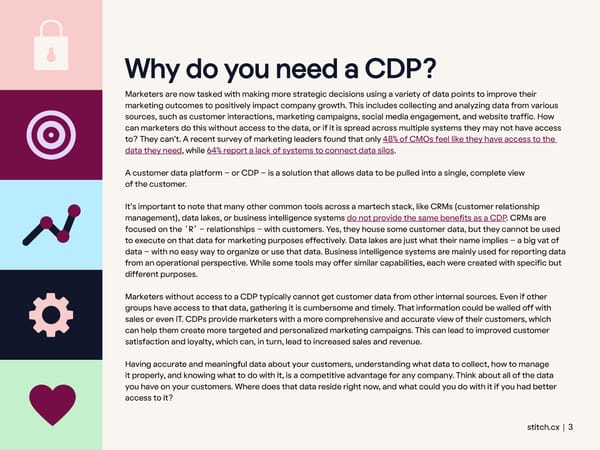WhWhy do yy do you need a CDPou need a CDP?? Marketers are now tasked with making more strategic decisions using a variety of data points to improve their marketing outcomes to positively impact company growth. This includes collecting and analyzing data from various sources, such as customer interactions, marketing campaigns, social media engagement, and website traffic. How can marketers do this without access to the data, or if it is spread across multiple systems they may not have access to? They can’t. A recent survey of marketing leaders found that only 48% of CMOs feel like they have access to the data they need, while 64% report a lack of systems to connect data silos. A customer data platform - or CDP - is a solution that allows data to be pulled into a single, complete view of the customer. It’s important to note that many other common tools across a martech stack, like CRMs (customer relationship management), data lakes, or business intelligence systems do not provide the same benefits as a CDP. CRMs are focused on the ‘R’ - relationships - with customers. Yes, they house some customer data, but they cannot be used to execute on that data for marketing purposes effectively. Data lakes are just what their name implies - a big vat of data - with no easy way to organize or use that data. Business intelligence systems are mainly used for reporting data from an operational perspective. While some tools may offer similar capabilities, each were created with specific but different purposes. Marketers without access to a CDP typically cannot get customer data from other internal sources. Even if other groups have access to that data, gathering it is cumbersome and timely. That information could be walled off with sales or even IT. CDPs provide marketers with a more comprehensive and accurate view of their customers, which can help them create more targeted and personalized marketing campaigns. This can lead to improved customer satisfaction and loyalty, which can, in turn, lead to increased sales and revenue. Having accurate and meaningful data about your customers, understanding what data to collect, how to manage it properly, and knowing what to do with it, is a competitive advantage for any company. Think about all of the data you have on your customers. Where does that data reside right now, and what could you do with it if you had better access to it? stitch.cx | 3
 23Q1 Ebook Page 2 Page 4
23Q1 Ebook Page 2 Page 4